Kunsthistorisches Museum
The Kunsthistorisches Museum (lit. "Museum of Art History", also often referred to as the "Museum of Fine Arts") is an art museum in Vienna, Austria. Housed in its festive palatial building on Ringstraße, it is crowned with an octagonal dome. The term Kunsthistorisches Museum applies to both the institution and the main building. It is the largest art museum in the country and one of the most important museums worldwide.
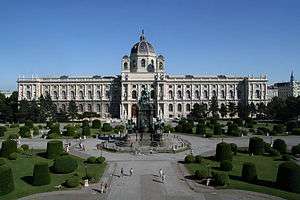 | |
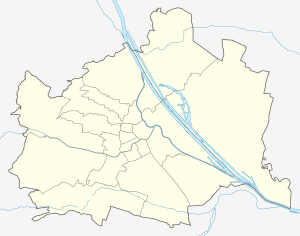 Location within Vienna | |
| Established | 1871-1891 |
|---|---|
| Location | Maria Theresien Platz Vienna, Austria |
| Type | Art Museum |
| Visitors | 1.745.070 (2019)[1] |
| Director | Sabine Haag (since 2009) |
| Architect | Karl Hasenauer, Gottfried Semper |
| Website | www |
_-_Google_Art_Project_-_edited.jpg)
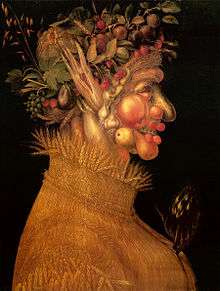

It was opened around 1891 at the same time as the Natural History Museum, Vienna, by Emperor Franz Joseph I of Austria-Hungary.[2] The two museums have similar exteriors and face each other across Maria-Theresien-Platz. Both buildings were built between 1871 and 1891 according to plans drawn up by Gottfried Semper and Baron Karl von Hasenauer. The two Ringstraße museums were commissioned by the emperor in order to find a suitable shelter for the Habsburgs' formidable art collection and to make it accessible to the general public. The buildings are rectangular in shape, and topped with a dome that is 60 meters high. The façade was built of sandstone. The inside of the museums is lavishly decorated with marble, stucco ornamentations, gold-leaf and paintings. The staircase of the Kunsthistorisches Museum is equipped with paintings by Gustav Klimt, Ernst Klimt, Franz Matsch, Hans Makart and Mihály Munkácsy.[3]
Collection
Picture gallery
The museum's primary collections are those of the Habsburgs, particularly from the portrait and armour collections of Ferdinand of Tirol, the collections of Emperor Rudolph II (the largest part of which is, however, scattered), and the collection of paintings of Archduke Leopold Wilhelm, of which his Italian paintings were first documented in the Theatrum Pictorium.
Notable works in the picture gallery include:
- Jan van Eyck: Portrait of Cardinal Niccolò Albergati (c. 1431)
- Antonello da Messina: San Cassiano Altarpiece (1475–1476)
- Raphael:
- Madonna of the Meadow (1506)
- St Margaret and the Dragon (1518)
- Albrecht Dürer:
- Avarice (1507)
- Adoration of the Trinity (1511)
- Titian:
- The Bravo (1516–17)
- Portrait of Isabella d'Este (1534–36)
- Lorenzo Lotto: Madonna and Child with Saint Catherine and Saint James (c.1527)
- Tintoretto: Susanna and the Elders (1555–56)
- Pieter Brueghel the Elder:
- The Fight Between Carnival and Lent (1559)
- Children's Games (1560)
- The Tower of Babel (1563)
- The Procession to Calvary (1564)
- The Gloomy Day (February - March) (1565)
- The Return of the Herd (October - November) (1565)
- The Hunters in the Snow (December - January) (1565)
- The Peasant and the Nest Robber (Bauer und Vogeldieb), 1568
- The Peasant Wedding (1568/69)
- The Peasant Dance (1568/69)
- Giuseppe Arcimboldo:
- The Four Seasons
- Summer (1563)
- The Four Seasons
- Michelangelo Merisi da Caravaggio:
- The Crowning with Thorns (c. 1602–04)
- Madonna of the Rosary (1606–07)
- David with the Head of Goliath
- Peter Paul Rubens:
- Miracles of St. Francis Xavier
- Angelica and the Hermit (1626–28)
- Ildefonso Altarpiece (1630–32)
- Self-Portrait (1638–39)
- The Fur (1638)
- Rembrandt: Self Portrait (1652)
- Johannes Vermeer: The Art of Painting (1665–66)
- Diego Velázquez: Several portraits of the Spanish royal family, a branch of the Habsburg, sent to Vienna.
- Thomas Gainsborough: Landscape in Suffolk (1748; currently not on display)
The collections of the Kunsthistorisches Museum:
- Egyptian and Near Eastern Collection
- Collection of Greek and Roman Antiquities
- Collection of Sculpture and Decorative Arts
- Coin Cabinet
- Library
Hofburg
- Ephesus Museum
- Collection of Ancient Musical Instruments
- Collection of Arms and Armour
- Archive
- Secular and Ecclesiastical Treasury (in the Schweizerhof)
Others
- Museum of Carriages and Department of Court Uniforms (in Schönbrunn Palace)
- Collections of Ambras Castle (in Innsbruck)
- the Austrian Theatre Museum in Palais Lobkowitz
Also affiliated are the:
- Museum of Ethnology in the Neue Burg (affiliated in 2001);
- Lipizzaner-Museum in the Stallburg
Recent events
One of the museum's most important objects, the Cellini Salt Cellar sculpture by Benvenuto Cellini, was stolen on May 11, 2003 and recovered on January 21, 2006, in a box buried in a forest near the town of Zwettl, Austria. It was featured in an episode of Museum Secrets on the History Channel. It had been the biggest art theft in Austrian history.[4]
The museum is the subject of Johannes Holzhausen's documentary film The Great Museum (2014), filmed over two years in the run up to the re-opening of the newly renovated and expanded Kunstkammer rooms in 2013.
From October 2018 through January 2019 was shown the world's largest-ever exhibition of works by Pieter Bruegel the Elder called Bruegel – Once in a Lifetime”.[5]
Gallery
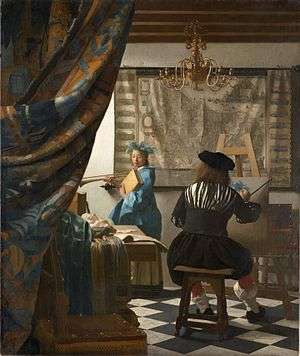
_-_Google_Art_Project.jpg)



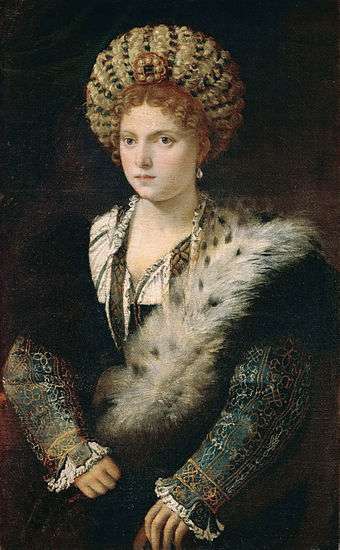
 One of the galleries
One of the galleries Cupola of museum
Cupola of museum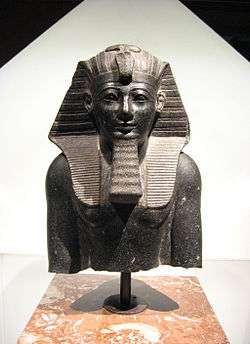 Statue of Thutmosis III
Statue of Thutmosis III Cupid the Honey Thief, drawing by Albrecht Dürer
Cupid the Honey Thief, drawing by Albrecht Dürer Statue outside the Kunsthistorisches Museum
Statue outside the Kunsthistorisches Museum A loving cup of King Ladislaus IV of Poland
A loving cup of King Ladislaus IV of Poland
References
- [https://www.derstandard.de/story/2000113948737/bundesmuseen-2019-rekord-mit-6-93-millionen-besuchern
- The Office Of The High Chamberlain (Dec 31, 1906). Guide to the Treasury of the Imperial House of Austria. Vienna, Austria: A. Holzhausen. p. 12.
- Gustav Klimt and Egyptian Art. Paintings in the staircase of the Kunsthistorisches Museum. by Ernst Czerny.
- "Police find stolen £36m figurine". BBC News. 2006-01-22. Retrieved 2013-09-16.
- "The Best of Bruegel – Only in Vienna". www.khm.at. Retrieved 2019-12-06.
External links
![]()

